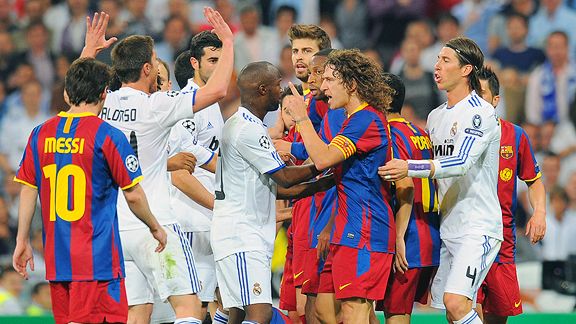Read football & basketball articles and other sports only at Finessekick.com
The History of El Clasico: The Fierce Rivalry of Two Spanish Giants
El Clasico is one of the most anticipated matches in the world of football. The duel between two Spanish giants, Real Madrid and FC Barcelona, is always full of emotion, rivalry, and a long history filled with drama. This encounter not only involves the match on the field but also represents the cultural, political, and regional identity differences between the two largest cities in Spain, Madrid and Barcelona.
FOOTBALL
Sidiq Zulkarnain
11/4/20243 min read


The Beginning of the Rivalry (1902 - 1930s)
The first match between Real Madrid and Barcelona took place in 1902 in a domestic cup competition called Copa de la Coronación, which was the precursor to the Copa del Rey. In that match, Barcelona defeated Madrid 3-1. Since then, the rivalry between the two clubs began to form, although in the early days it was more about sports and had not yet touched on political or cultural aspects.
In 1929, when La Liga was first held, Madrid and Barcelona met in an official league match that further cemented their rivalry. Both became clubs that competed fiercely for domestic titles, and from here El Clasico began to be widely known by football fans throughout Spain.
Political Factors and Cultural Differences (1940s - 1970s)
Entering the 1940s, the El Clasico rivalry was not just about sports but also touched on politics. During the dictatorship of General Franco, Real Madrid was seen as a symbol of the central Spanish government, while Barcelona became a representation of resistance and pride for the Catalonia region, which had a different identity, language, and culture from other parts of Spain.
One famous incident occurred in 1943, in the Copa del Generalísimo (now Copa del Rey), where Real Madrid defeated Barcelona with a score of 11-1. This victory was full of controversy, with many rumors about government intimidation of Barcelona players. This event further strengthened the political tension between the two clubs.
Era of Glory and Iconic Players (1980s - 2000s)
In the 1980s and 1990s, El Clasico became more festive with the presence of star players. World-class players like Alfredo Di Stefano, Johan Cruyff, and Maradona colored these matches. In the 1990s, Luis Figo created controversy when he moved from Barcelona to Real Madrid, which was considered a great "betrayal" by Barcelona fans.
In the early 2000s, the rivalry heated up with the presence of great players in both clubs. The "Galacticos" era of Real Madrid, strengthened by Zidane, Ronaldo, Beckham, and Raul, faced Barcelona with Ronaldinho, Xavi, and later Lionel Messi. Both clubs competed not only in La Liga but also in the European Champions League, making El Clasico one of the most prestigious matches in the world.
Lionel Messi vs Cristiano Ronaldo Era (2009 - 2018)
The Messi and Ronaldo era was one of the most competitive periods in El Clasico history. Both were considered the two best players in the world, and their meetings in El Clasico always drew global attention. The matches between Real Madrid and Barcelona during this era were not only a rivalry between two clubs but also between two players competing in terms of achievements, goals, and individual awards.
During this era, El Clasico matches were often marked by new records and high tension on the field. Ronaldo and Messi brought the El Clasico rivalry to a new level, where both clubs strived to dominate both domestic and European competitions with extraordinary intensity.
Modern El Clasico
After the Messi and Ronaldo era ended, El Clasico remains a highly anticipated match by football fans worldwide. Although these legendary players have moved to other clubs, Real Madrid and Barcelona continue to bring in new star players and develop competitive game strategies. The presence of talented young players like Vinicius Junior at Real Madrid and Gavi at Barcelona adds new color to this rivalry.
El Clasico is now seen not only as a match but also as a symbol of history, differences, and competitive spirit. With such a rich political, social, and cultural background, El Clasico never loses its appeal and remains one of the greatest encounters in football history.
Conclusion
The history of El Clasico is a story of rivalry between two giant clubs rooted in more than just a game of football. It is a story of identity, pride, and the desire to show superiority, both in Spain and on the international stage. Regardless of who wins or loses, El Clasico always becomes the spotlight of the football world, bringing together fans from all over the world to witness one of the most prestigious matches in the world.
FinesseKick.com
Discover the latest articles about the world of sports.
Know More
Contact
© 2024. All rights reserved.
